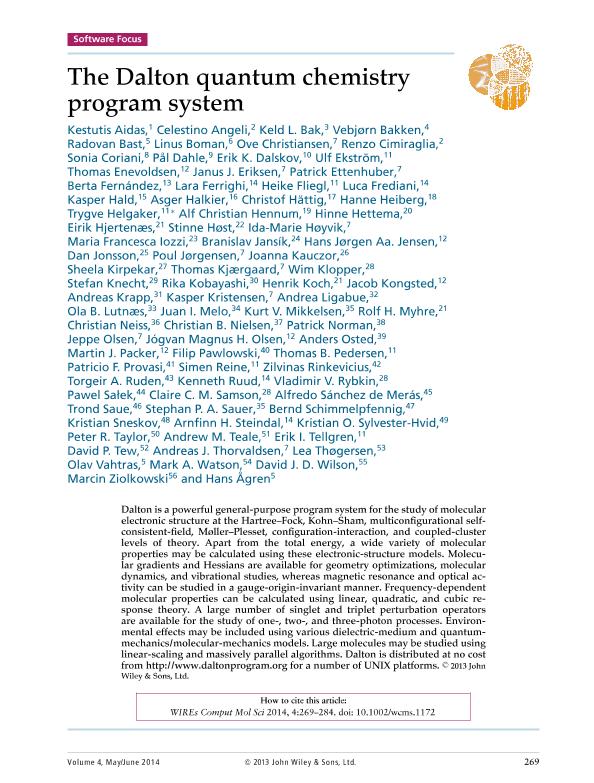Artículo
The Dalton quantum chemistry program system
Aidas, Kestudis; Angeli, Celestino; Bak, Keld L.; Bakken, Vebjørn; Bast, Radovan; Boman, Linus; Chistiansen, Ove; Coriani, Sonia ; Dahle, Pål; Dalskov, Eric K.; Ekström, Ulf; Enevoldsen, Thomas
; Dahle, Pål; Dalskov, Eric K.; Ekström, Ulf; Enevoldsen, Thomas ; Eriksen, Janus J.; Ettenhuber, Patrick; Fernández, Berta; Ferrighi, Lara
; Eriksen, Janus J.; Ettenhuber, Patrick; Fernández, Berta; Ferrighi, Lara ; Fliegl, Heike; Frediani, Luca
; Fliegl, Heike; Frediani, Luca ; Hald, Kasper; Kalkier, Asger; Hättig, Chistof; Heiberg, Hanne
; Hald, Kasper; Kalkier, Asger; Hättig, Chistof; Heiberg, Hanne ; Helgaker, Trygve; Hennum, Alf Christian
; Helgaker, Trygve; Hennum, Alf Christian ; Hettema, Hinne
; Hettema, Hinne ; Hjertenæs, Eirik
; Hjertenæs, Eirik ; Høst, Stinne; Melo, Juan Ignacio
; Høst, Stinne; Melo, Juan Ignacio ; Provasi, Patricio Federico
; Provasi, Patricio Federico
 ; Dahle, Pål; Dalskov, Eric K.; Ekström, Ulf; Enevoldsen, Thomas
; Dahle, Pål; Dalskov, Eric K.; Ekström, Ulf; Enevoldsen, Thomas ; Eriksen, Janus J.; Ettenhuber, Patrick; Fernández, Berta; Ferrighi, Lara
; Eriksen, Janus J.; Ettenhuber, Patrick; Fernández, Berta; Ferrighi, Lara ; Fliegl, Heike; Frediani, Luca
; Fliegl, Heike; Frediani, Luca ; Hald, Kasper; Kalkier, Asger; Hättig, Chistof; Heiberg, Hanne
; Hald, Kasper; Kalkier, Asger; Hättig, Chistof; Heiberg, Hanne ; Helgaker, Trygve; Hennum, Alf Christian
; Helgaker, Trygve; Hennum, Alf Christian ; Hettema, Hinne
; Hettema, Hinne ; Hjertenæs, Eirik
; Hjertenæs, Eirik ; Høst, Stinne; Melo, Juan Ignacio
; Høst, Stinne; Melo, Juan Ignacio ; Provasi, Patricio Federico
; Provasi, Patricio Federico
Fecha de publicación:
05/2014
Editorial:
Wiley
Revista:
Wires
e-ISSN:
1759-0884
Idioma:
Inglés
Tipo de recurso:
Artículo publicado
Clasificación temática:
Resumen
Dalton is a powerful general-purpose program system for the study of molecular electronic structure at the Hartree–Fock, Kohn–Sham, multiconfigurational selfconsistent-field, Møller–Plesset, configuration-interaction, and coupled-cluster levels of theory. Apart from the total energy, a wide variety of molecular properties may be calculated using these electronic-structure models. Molecular gradients and Hessians are available for geometry optimizations, molecular dynamics, and vibrational studies, whereas magnetic resonance and optical activity can be studied in a gauge-origin-invariant manner. Frequency-dependent molecular properties can be calculated using linear, quadratic, and cubic response theory. A large number of singlet and triplet perturbation operators are available for the study of one-, two-, and three-photon processes. Environmental effects may be included using various dielectric-medium and quantummechanics/molecular-mechanics models. Large molecules may be studied using linear-scaling and massively parallel algorithms. Dalton is distributed at no cost from http://www.daltonprogram.org for a number of UNIX platforms.
Palabras clave:
Dalton
,
Program
,
Molecular
,
Properties
,
Computational
Archivos asociados
Licencia
Identificadores
Colecciones
Articulos(IFIBA)
Articulos de INST.DE FISICA DE BUENOS AIRES
Articulos de INST.DE FISICA DE BUENOS AIRES
Articulos(IMIT)
Articulos de INST.DE MODELADO E INNOVACION TECNOLOGICA
Articulos de INST.DE MODELADO E INNOVACION TECNOLOGICA
Citación
Aidas, Kestudis; Angeli, Celestino; Bak, Keld L.; Bakken, Vebjørn; Bast, Radovan; et al.; The Dalton quantum chemistry program system; Wiley; Wires; 4; 3; 5-2014; 269-284
Compartir
Altmétricas



